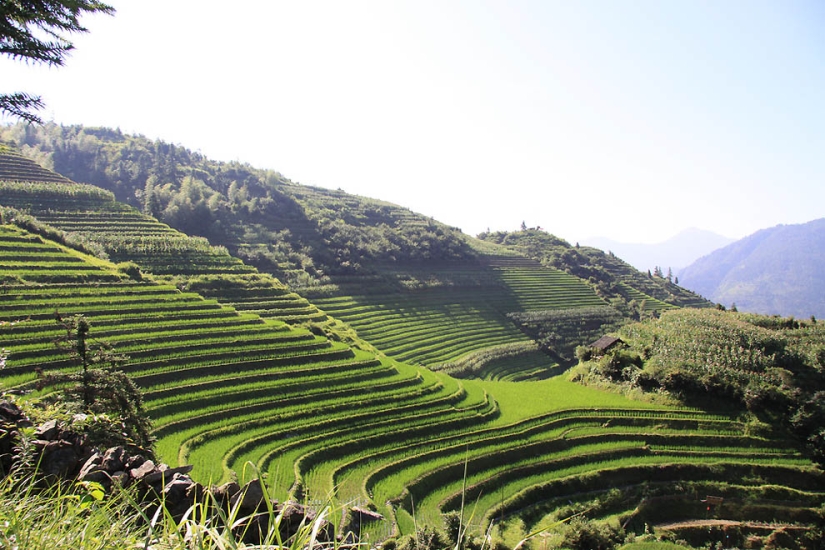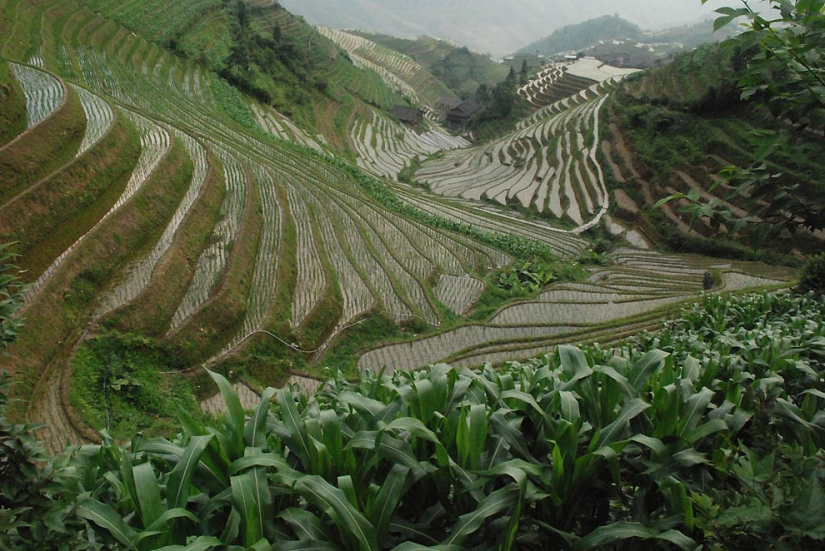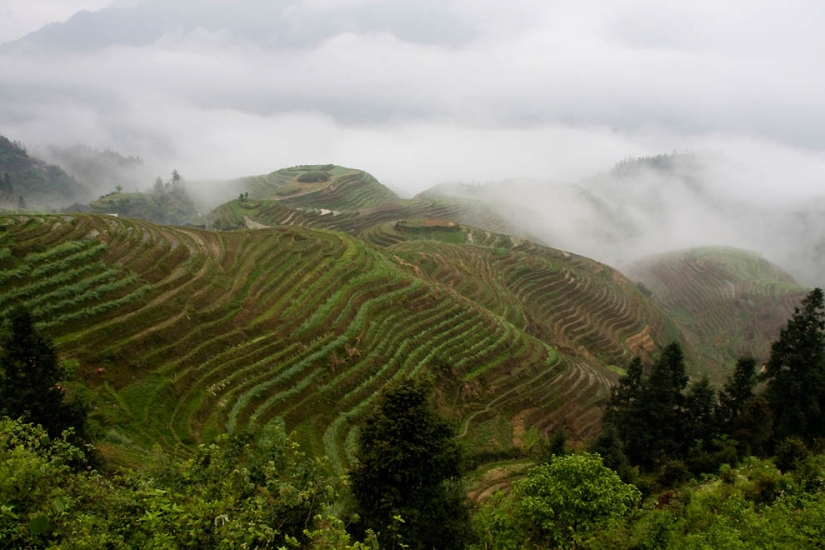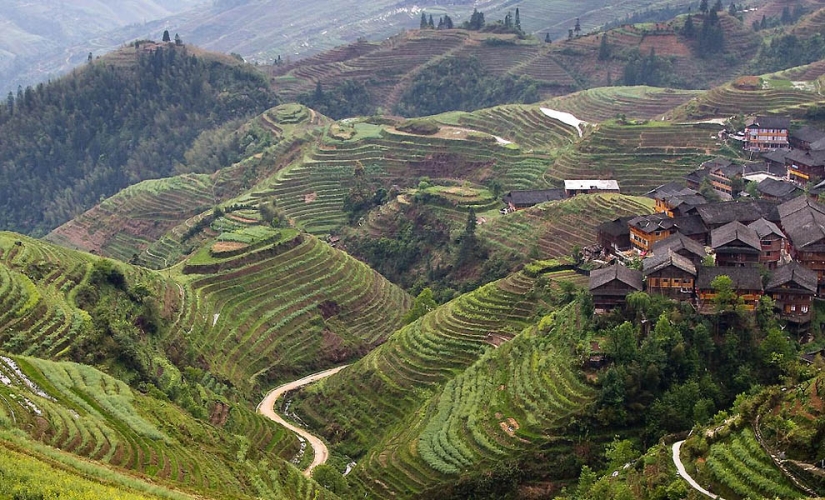Dragon Ridge Rice Terraces
Categories: World
By Pictolic https://pictolic.com/article/dragon-ridge-rice-terraces1.htmlLocated 27 km south of the town of Longsheng, extensive rice terraces "Dragon Ridge" (Longji) cover the hills and mountains layer by layer. These are some of the most famous terraces in all of China, famous far beyond China for their fabulous landscapes.


The old men of Longsheng have a saying: "Where there is land, there will be a rice terrace." In the Chinese province of Guangxi, a two-hour drive from the city of Guilin, the problem of sowing and growing rice on steep slopes has long been solved. Even the Yuan Dynasty at the end of the 13th century began the implementation of a large - scale task of sowing rice in the Longsheng Mountains .


It took four centuries to create the rice fields known as Longji. During this time, many generations have worked hard on the terraces to provide their families with an annual supply of rice. But in addition, they have created an amazing beauty of the area. It's not for nothing that the Chinese call this little miracle a "delightful terrace".


This area looks different at different times of the year. The accumulated water over the winter is poured into the fields in the spring in the form of rains. In summer, thanks to the winds that stir the rice shoots, the fields turn into green rice fields. In autumn, the ripe harvest field acquires a noble golden color, and in winter the entire slope is covered with snow.


The people who were forced to settle en masse in this hilly area during the reign of the Yuan Dynasty had a problem of crop shortage due to the peculiarities of the local region: the increasing population could not get a large enough harvest. Therefore, people have come up with an unusual technique for better use of arable land.


The pinnacle of human ingenuity is natural rainwater runoff, which is the only source of water in a mountainous area. Water is stored in reservoirs, and in the spring rice fields are flooded with water. The staggered terraces ensure the use of all the water without any residue.


In Longsheng, in mountain villages near rice terraces, ethnic groups such as Zhuang, Dong and Yao live. Residents of local villages wear national clothes (although some of the outfits are intended for tourists), and the women of the Dong have very long hair.


Representatives of the Zhuan ethnic group call the terraces "The Spine of the Dragon". From an 800-meter height, the naked eye can see that the fields look like the scales of a dormant dragon with a writhing spine.


Rice fields, the highest point of which is located at an altitude of 1100 meters, occupy an area of 60 sq.km. This is not a place where you can come for a couple of hours to admire the scenery. Travelers wishing to see this remote area are advised to stop for at least 2 days.


Visitors are always welcome here, and many locals even open small inns for travelers. Visiting rice fields, you can learn a lot about the culture and peculiarities of the local population. It is better to visit the terraces in spring or summer to discover them in the best possible way. Arriving in autumn, you will see tall rice, terraces will look like undulating hills.


For centuries, rice terraces have been in the possession of families, from generation to generation they were passed from father to son. When the Communists came to power, the rules changed: at the birth of a person, a certain land allotment is allocated to him, and after death, the local committee alienates him for its use and later transfers him to someone else.

Although every family is able to grow crops only for their own needs, rice is grown here not only for food. After all, there is always a place for small joys in life. And every year a part of the harvest, the so-called glutinous rice, is used to produce rice wine.


Now, when the twenty-first century is in the yard, the role of rice fields, of course, is not as important as before. More and more young people are going to work in Longsheng or even further. And, despite the fact that the terraces are still planted with rice, they no longer serve as the main source of income for the local population.


A few years ago, unscrupulous tour operators used these lands, while not wanting to share with the local population the profits received from tourists. In this regard, local residents said they would stop flooding the fields and growing rice. In this case, it made no sense for tourists to go to the region. Needless to say, soon after this threat, tour operators began negotiations with local residents.


The rice grown here cannot be sold at a competitive price, since the area of the terraces simply does not allow to receive large volumes of grain. However, rice fields are increasingly included in tourist maps, and villagers earn more from tourism every year than from rice fields. Therefore, there will be rice plantations in Longsheng until tourists get bored with them.

However, this is unlikely to happen, given the amazing beauty of the landscapes.

Keywords: China | Peasants | Fields | Rice | Terrace | Tourism
Post News ArticleRecent articles
Few supermodels can boast such a complex and eventful fate as Veruschka. She was born a countess into one of the most famous German ...

In 1922, the 16-year-old canadian Aloha Vandervell went on an adventurous expedition through the world by car Ford Model‑T became ...
Related articles

The period of the Civil war will forever remain in history as a time of anarchy, violence and destruction. This era has produced ...

China is a country of striking contrasts where ancient traditions meet new technology and serene rural landscapes coexist with ...

Folk remedies used to treat ailments in Russia were numerous and varied. The carriers of knowledge about the means and methods of ...

Famous Russian proverb "do Not spit into the well, it is useful to drink water" perfectly describes what you will see on these ...